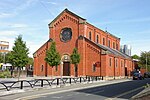Canterbury Street drill hall, Blackburn
Buildings and structures in BlackburnDrill halls in EnglandGrade II listed buildings in LancashireUse British English from June 2017

The Canterbury Street drill hall is a military installation in Blackburn, Lancashire. It is a Grade II listed building.
Excerpt from the Wikipedia article Canterbury Street drill hall, Blackburn (License: CC BY-SA 3.0, Authors, Images).Canterbury Street drill hall, Blackburn
Weir Street,
Geographical coordinates (GPS) Address Nearby Places Show on map
Geographical coordinates (GPS)
| Latitude | Longitude |
|---|---|
| N 53.74425 ° | E -2.4844 ° |
Address
Weir Street
Weir Street
BB2 2AN , Wensley Fold
England, United Kingdom
Open on Google Maps






